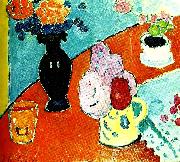alexej von jawlenskij Huiler la Reproduction de TableauAll alexej von jawlenskij Oil PaintingsAlexej Georgewitsch von Jawlensky (13 March 1864 ?C 15 March 1941) was a Russian expressionist painter active in Germany. He was a key member of the New Munich Artist's Association (Neue Kunstlervereinigung Menchen), Der Blaue Reiter (The Blue Rider) group and later the Die Blaue Vier (The Blue Four). Alexej von Jawlensky was born in Torzhok, a town in Tver Governorate, Russia, as the fifth child of Georgi von Jawlensky and his wife Alexandra (n??e Medwedewa). At the age of ten he moved with his family to Moscow. After a few years of military training, he became interested in painting, visiting the Moscow World Exposition circa 1880. In 1896 he moved to Munich, where he studied in the private school of Anton Ažbe. In Munich he met Wassily Kandinsky and various other Russian artists, and he contributed to the formation of the Neue K??nstlervereinigung M??nchen. His work in this period was lush and richly coloured, but later moved towards abstraction and a simplified, formulaic style. Alexej von Jawlensky. Abstract Head, c. 1928Von Jawlensky died in Wiesbaden, Germany on 15 March 1941. He and his wife Helene are buried in the cemetery of St. Elizabeth's Church, Wiesbaden. |
|||

|
|||
|
|
|||
|
||||||||||||
| alexej von jawlenskij Alexej Georgewitsch von Jawlensky (13 March 1864 ?C 15 March 1941) was a Russian expressionist painter active in Germany. He was a key member of the New Munich Artist's Association (Neue Kunstlervereinigung Menchen), Der Blaue Reiter (The Blue Rider) group and later the Die Blaue Vier (The Blue Four). Alexej von Jawlensky was born in Torzhok, a town in Tver Governorate, Russia, as the fifth child of Georgi von Jawlensky and his wife Alexandra (n??e Medwedewa). At the age of ten he moved with his family to Moscow. After a few years of military training, he became interested in painting, visiting the Moscow World Exposition circa 1880. In 1896 he moved to Munich, where he studied in the private school of Anton Ažbe. In Munich he met Wassily Kandinsky and various other Russian artists, and he contributed to the formation of the Neue K??nstlervereinigung M??nchen. His work in this period was lush and richly coloured, but later moved towards abstraction and a simplified, formulaic style. Alexej von Jawlensky. Abstract Head, c. 1928Von Jawlensky died in Wiesbaden, Germany on 15 March 1941. He and his wife Helene are buried in the cemetery of St. Elizabeth's Church, Wiesbaden. |
||||||||||||
|
|
||||||||||||
| ID de tableau:: 67568 stilleben stilleben 1909 se 1909 se |
||||||||||||
|
|
||||||||||||
|
| Artiste précédent Artiste prochain | |||||||||||
|
|
||||||||||||
|
alexej von jawlenskij Alexej Georgewitsch von Jawlensky (13 March 1864 ?C 15 March 1941) was a Russian expressionist painter active in Germany. He was a key member of the New Munich Artist's Association (Neue Kunstlervereinigung Menchen), Der Blaue Reiter (The Blue Rider) group and later the Die Blaue Vier (The Blue Four). Alexej von Jawlensky was born in Torzhok, a town in Tver Governorate, Russia, as the fifth child of Georgi von Jawlensky and his wife Alexandra (n??e Medwedewa). At the age of ten he moved with his family to Moscow. After a few years of military training, he became interested in painting, visiting the Moscow World Exposition circa 1880. In 1896 he moved to Munich, where he studied in the private school of Anton Ažbe. In Munich he met Wassily Kandinsky and various other Russian artists, and he contributed to the formation of the Neue K??nstlervereinigung M??nchen. His work in this period was lush and richly coloured, but later moved towards abstraction and a simplified, formulaic style. Alexej von Jawlensky. Abstract Head, c. 1928Von Jawlensky died in Wiesbaden, Germany on 15 March 1941. He and his wife Helene are buried in the cemetery of St. Elizabeth's Church, Wiesbaden. |
||||||||||||
|
|
||||||||||||
|
CONTACTER DES Etats-Unis |






